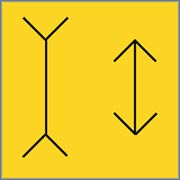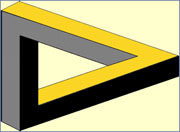|
|
| |
 |
Vision |  |
| | |





Better
Optical Illusions
Adelson’s
Checkerboard
Will
You Be the Same Person in 10 Years As You are Now?
Optical
illusions appear to depend not only on the human visual system but also on human culture. For example,
Westerners seem to experience the Müller-Lyer illusion more strongly and
the inverted-T illusion less strongly (see pictures to the right) than other ethnic
groups, especially Africans.
One possible explanation would be that
Westerners live in a world where geometric shapes with right angles predominate
(buildings with perpendicular lines, vertical walls, horizontal ceilings, etc.).
Many experiments also show that Westerners have a very strong tendency to overestimate
acute angles and underestimate obtuse ones, as if they were trying to force everything
back to a right angle. And that is why Westerners are more sensitive to the Müller-Lyer
illusion.
Conversely, the reason that Africans are more sensitive to
the inverted-T illusion would be the geography of the African savannah, with very
flat topography and almost no trees, houses, or poles. Africans would therefore
be less used to judging vertical lines and hence more easily deceived by the inverted-T
illusion.  | |
|
| WHAT OPTICAL ILLUSIONS SHOW US ABOUT VISUAL PERCEPTION |
| The particular way that
certain elements in a scene are arranged visually can force your brain to make
mistakes about the size of objects, the colour of surfaces, or the straightness
of lines. These systematic errors are called optical illusions,
and hundreds of them are now known. Most of the mechanisms that cause optical
illusions are fairly well understood, but some of them are still a mystery.
Optical illusions
give us a better understanding of how human visual perception works. They force
us to recognize that contrary to what we might think, what we see of the world
is not a simple physical record like a photograph. On the contrary, the signals
that your eyes receive from the elements in a scene in front of them are often
ambiguous. Your brain is constantly interpreting these signals to construct an
image that makes sense to it. In fact, your brain tries so hard to make sense
of everything that it often finds meaning even where there is none, thus creating
optical illusions.
There are several distinct families of optical illusions. Geometric
illusions are produced by the arrangement of points, lines, and simple
shapes in ways that make you misinterpret these elements when you see them. Many
geometric illusions involve two objects that are actually identical but look different
because of their surroundings. | | 
One
of the optical illusions that has been most studied was created by German psychiatrist
Franz Müller-Lyer in 1889. Though the line between the arrows on the left
looks longer than the one on the right, the two lines are the same length. (If
you don't believe it, place your mouse cursor over the picture!) 

The
inverted-T illusion: the vertical line looks longer than the horizontal one but
is actually the same length. This illusion is thought to result from two factors:
first, the eyes scan horizontal lines more easily than vertical ones, and second,
the vertical line divides the horizontal one into two smaller segments. |

Many
works by M.C. Escher are based on this principle. | In
artistic optical illusions, it is not that the human visual system
interprets reality incorrectly, but rather that the reality itself is deliberately
ambiguous. Using various tricks of drawing, the artist
creates an object that looks realistic but could never actually be built in the
real world. 
A simple
artistic optical illusion: the impossible triangle

|
Some optical illusions are caused
not by the brain's misinterpreting some aspect of reality, but rather by physical
phenomena that distort reality's usual appearance so that the eyes can
record only the distortion. Mirages are a good example of this
kind of optical illusion. A more common example is the way that the sun appears
to flatten out as it sets, because its light rays are passing through a thicker
layer of atmosphere to reach your eyes. |
|
|








